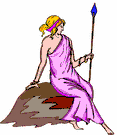The Amazon River
The Amazon is the world's second-longest river at 3,980 miles. But the Amazon is one of the widest rivers on Earth, at times six whole miles wide. A full 20 percent of the water that pours out of the planet's rivers into the oceans comes from the Amazon.
 The
Amazon dominates South America, collecting water from 40
percent of the continent, in the form of thousands of
tributaries, many of which are themselves more than 1000
miles long.
The
Amazon dominates South America, collecting water from 40
percent of the continent, in the form of thousands of
tributaries, many of which are themselves more than 1000
miles long.
The
Amazon River is part of a larger area called the Amazon
Rainforest, which has a unique assortment of plants and
animals. In some spots, the vegetation is so dense that
sunlight can't reach the rainforest floor.
 Spanish
explorer Francisco de Orellana gave the river its name and
was the first European to travel the length of the river. In
1541-2, he and his men encountered a tribe of fierce women
who reminded him of the story from ancient Greece about
Amazons, who were warrior women. Perhaps to warn later
travelers about these fierce women, he named the river
Amazon.
Spanish
explorer Francisco de Orellana gave the river its name and
was the first European to travel the length of the river. In
1541-2, he and his men encountered a tribe of fierce women
who reminded him of the story from ancient Greece about
Amazons, who were warrior women. Perhaps to warn later
travelers about these fierce women, he named the river
Amazon.
As
with the Nile, the people who lived along the Amazon in
ancient times used the river for agriculture and
transportation. That hasn't changed.
Facts About the Amazon River
|
Length
|
3,980 miles |
|
Source(s)
|
Iquitos, Peru
|
|
Mouth
|
Atlantic Ocean, off Brazil
|
|
Countries Flows Through
|
Brazil and Peru
|
|
Major Cities Flows By/Through
|
Manaus and Macapa Brazil; Iquitos, Peru
|
|
Where Name Comes From
|
Amazons, warrior women in the Greek tradition
|



 The
Amazon dominates South America, collecting water from 40
percent of the continent, in the form of thousands of
tributaries, many of which are themselves more than 1000
miles long.
The
Amazon dominates South America, collecting water from 40
percent of the continent, in the form of thousands of
tributaries, many of which are themselves more than 1000
miles long.
 Spanish
explorer Francisco de Orellana gave the river its name and
was the first European to travel the length of the river. In
1541-2, he and his men encountered a tribe of fierce women
who reminded him of the story from ancient Greece about
Amazons, who were warrior women. Perhaps to warn later
travelers about these fierce women, he named the river
Amazon.
Spanish
explorer Francisco de Orellana gave the river its name and
was the first European to travel the length of the river. In
1541-2, he and his men encountered a tribe of fierce women
who reminded him of the story from ancient Greece about
Amazons, who were warrior women. Perhaps to warn later
travelers about these fierce women, he named the river
Amazon.

